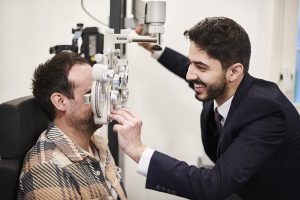Is there a Prescription Limit for Laser Eye Surgery?

It is a common misconception that the numbers on your prescription card are enough to determine your eligibility for Laser Eye Surgery.
Many people believe that their prescription alone will impact their suitability for treatment, but the truth is, the process of determining eligibility is a lot more involved than that.
In fact, the process, as well as the limits to Laser Eye Surgery, has changed significantly in recent years. So, if you find yourself assuming that your high prescription will make you unsuitable for treatment, don’t fret; the chances are you can still achieve excellent results with Laser Eye Surgery!
That being said, it certainly helps to understand the limits of Laser Eye Surgery to get a better idea of your suitability. So, with that in mind, let’s take a look at the current prescription limits for the three most common refractive errors: short-sightedness, long-sightedness, and astigmatism.
The prescription limits for short-sightedness (myopia)
Short-sightedness – also known as myopia – is the most common vision impairment globally. Ongoing studies reveal that this condition is becoming increasingly prevalent, with estimates suggesting that around half of the people on the planet will be considered short-sighted by 2050.
Short-sightedness is characterised by having difficulty seeing objects at a distance – such as road and street signs.
A prescription for myopia will be indicated on your prescription card with a negative (-) diopter value (D). A diopter is the unit of measurement used to represent the optical power of the cornea.
While it can vary, a typical Laser Eye Surgery clinic will qualify patients for LASIK treatment from -0.5 D to -8.0 D myopia. With a prescription of below 0.5 D, people only rarely require glasses, so LASIK is usually not recommended unless the patient also has some degree of astigmatism.
The maximum prescription for treatment is less easy to define. For instance, most clinics can treat patients with moderate to severe myopia up to about -8.0 D. However, patients at the high end of severe myopia will also be required to have thick and healthy corneas. This is because treatment at these higher prescriptions requires the removal of more tissue.
Luckily, some clinics (including here at London Vision Clinic) myopia can be treated even at prescriptions beyond -0.8 D. This is thanks to the latest innovation in Laser Eye Surgery – ReLEx SMILE. This technique allows surgeons to treat patients with thinner corneas and prescriptions higher than -10.0 D.
The prescription limits for far-sightedness (hyperopia)
Hyperopia, also known as hypermetropia, long-sightedness, or far-sightedness is less common than myopia but it is still estimated to affect around a quarter of the population.
Long-sightedness is characterised by difficulty in seeing and focusing on objects that are close up in your field of vision. The condition is also often associated with headaches, eye strain, and fatigue – particularly when completing tasks that involve a lot of close-up work, such as reading or using a computer.
As it presents in young people, hyperopia is different from the type of far-sightedness that appears as we begin to get older. This is a condition called presbyopia and, although it involves many of the same symptoms, requires a different solution.
Hyperopia is measured in positive (+) diopters. Like myopia, most clinics don’t perform LASIK on patients with very mild hyperopia, i.e. less than +1.0 diopters, unless there is also some degree of astigmatism.
At most clinics, the prescription limit for treating hyperopia with LAIK is typically somewhere between 3.0 to 4.0 D. The majority of clinics are currently unable to treat patients with severe hyperopia (5.0 D +) as they don’t have access to the latest technology to do so safely.
As with other prescriptions, however, your eligibility for Laser Eye Surgery varies according to several other factors, including the clinic you go to. Clinics with access to the leading technology and expertise can treat hyperopic prescriptions up to +7.0 D.
The prescription limit for astigmatism
Astigmatism is used to refer to abnormally shaped eyes – that is, eyes that aren’t spherical. In patients with astigmatism, the eyeball is shaped more like a rugby ball than a more round football. Astigmatism leads to vision issues as the shape of the eye can affect how light is bent into the retina, causing blurry vision, eye strain, or headaches.
While myopia is widely considered the most common refractive error, astigmatism would take the official crown as nobody’s eyes are perfectly spherical. This means that, in reality, pretty much everyone has some degree of astigmatism.
This condition frequently accompanies both myopia and hyperopia. Again, the severity of astigmatism is shown on your prescription card in positive and negative diopters
Whether it appears on its own or alongside other refractive errors, Laser Eye Surgery can typically treat astigmatism of up to 6.0 D.
As with other types of refractive error, the treatable range of astigmatism can vary between clinics. As it requires correction in more than one plane, astigmatism is generally slightly more complex to treat. But with the right technology and level of expertise, virtually all astigmatism symptoms are treatable – even high astigmatism cases are routine.
Ultimately, there is no clearly defined prescription limit for treating any refractive error with Laser Eye Surgery. The true answer will depend on a number of factors – not just prescription, making a thorough evaluation with a qualified consultant a must to determine your eligibility and which treatment option is right for you.
The best way to determine if your prescription is suitable for Laser Eye Surgery is through a thorough eye examination. Why not come in and see us. Book a Consultation or give us a call on 020 7224 1005.


